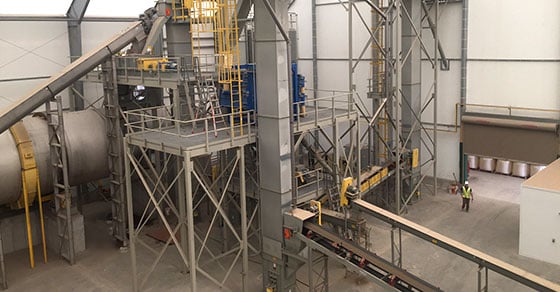The rising adoption of anaerobic digesters for food waste and on-farm use is bringing food production another step closer to a circular economy. This is particularly true when it comes to poultry and livestock production, where opportunities for manure granulation are improved through the use of a digester.
What follows is a look at this rising trend and the sustainability potential it brings to the table.
The Rise of Digester Adoption
Renewable energy incentives in the 1970s saw farms implement anaerobic digestion to sell their captured energy back to the electrical grid at a premium (with the help of an on-farm generator that converted methane to electricity). But when incentives went away, so too did the economic viability, causing farmers to flare their gas for carbon credits instead. This still contributed to a reduction in greenhouse gas emissions, but the economics didn’t incentivize further adoption of anaerobic digestion, leaving the technology as just another tool in the box.
Now, however, farms are again turning to anaerobic digestion as the demand for “green” natural gas grows; through anaerobic digestion, farmers can capture their methane emissions in the form of biogas and where location allows, inject it into nearby natural gas pipelines for conversion to a variety of value-added products. This green gas fetches a premium compared to traditionally mined “blue” gas, making the economics highly attractive.
According to the EPA’s AgStar data, the use of manure-based anaerobic digesters operating within the nation’s borders has steadily increased in the past two decades, starting at just 25 in 2000 and approaching 350 in 2023. 2023 also saw a spike in the number of digesters under construction. The rise is in part driven by the ongoing trend of industrialized farms, where animal production is highly concentrated. It also stems from state and federal incentives that began in 2011 aimed at limiting methane emissions.
It’s important to recognize that anaerobic digestion technology is not restricted solely to manures; other facilities processing organic wastes can also take advantage of the benefits it has to offer. This includes wastewater treatment plants, compost facilities, and municipalities or corporations processing food waste – all represent substantial opportunities for recovering the value contained within organic wastes and diverting wastes from landfills.
Digestate Treatment: Granulation Increases Value
With the primary focus of most facilities implementing a digester being the resulting biogas, the solids remaining after digestion have historically been considered a waste stream to be managed. However, because the digestion process concentrates nutrients and converts them to a more plant-available form, the solids remaining after digestion are essentially an upgraded source of nutrients, making their reuse more enticing.
While some farms are able to use a portion of the digestate as-is, it faces many of the same challenges associated with raw manure – costly transport, limited storage options, and more. As a result, on farms with the capacity to justify the cost, most choose to take the additional step of granulating their digestate, further upgrading its value.
By granulating digestate into a dry fertilizer product, farmers can eliminate waste management challenges and significantly increase the value and marketability of the product, creating an additional source of revenue, all while operating more sustainably and reducing their carbon footprint. Farms may also choose to use some of the product on farm for producing animal feed crops, promoting a closed nutrient cycle.
The Digestate Granulation Process
The granulation of digestate differs depending on the specific type of manure (or litter, in the case of some poultry production) and various on-farm practices and technologies. First however, all digestate must go through a solid/liquid separation process.
Solid/Liquid Separation (and Nutrient Capture)
After digestion and biogas capture, the remaining “digestate” is in the form of a slurry. This slurry has a high moisture content and can vary in consistency, making it an unsuitable feedstock for the granulation process.
A solid/liquid separation process such as dewatering is necessary to separate the solid from the liquid component. The resulting streams consist of a “nutrient cake” (the solid portion) and the extracted liquid portion, “tea water,” which can be used as a liquid fertilizer or employed in other non-potable uses on the farm. Once solid/liquid separation is complete, the granulation process can begin.
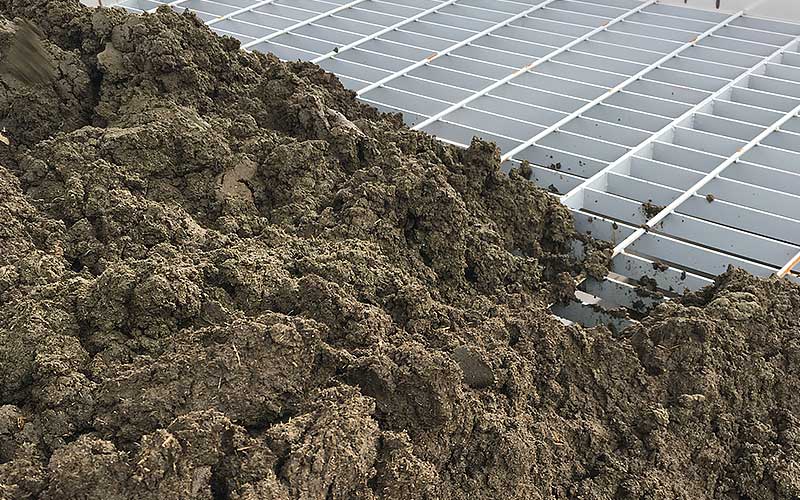
Nutrient cake after solid/liquid separation
While facilities processing raw manure (or chicken litter) may have a few different non-pressure granulation options available, digestate is typically best processed via the mixer-dryer approach to granulation (this approach is widely employed on large-scale dairy and hog farms). This process is illustrated here.
Preconditioning
If the nutrient cake is non-uniform in particle size distribution and/or moisture content after solid/liquid separation, some pretreatment such as grinding or additional drying may be necessary. If coarse fibers or sand are present, these will also require removal prior to granulation.
Mixing and Granule Formation
Mixing and granule formation are carried out in a pugmill mixer, a horizontal mixer that utilizes dual counter-rotating shafts fitted with paddles to impart a kneading and folding motion onto material. Any binder or beneficial additives can also be incorporated in this step.
Because the nutrient cake still has a fairly high moisture content, a high rate of recycle (dried material) is required to blend with the incoming wet feed to improve the flowability and bring it into a suitable moisture content for granulation. This process of mixing in dried recycle is also known as “back mixing.”
The kneading action of the pugmill mixer incorporates the wet material into the dry recycle, creating a homogeneous blend and breaking apart any clumps that may have formed.
As the material moves down the length of the mixer, the mixing action causes rough granules to form. These granules can move on to drying, or they can be further refined in a granulation drum.
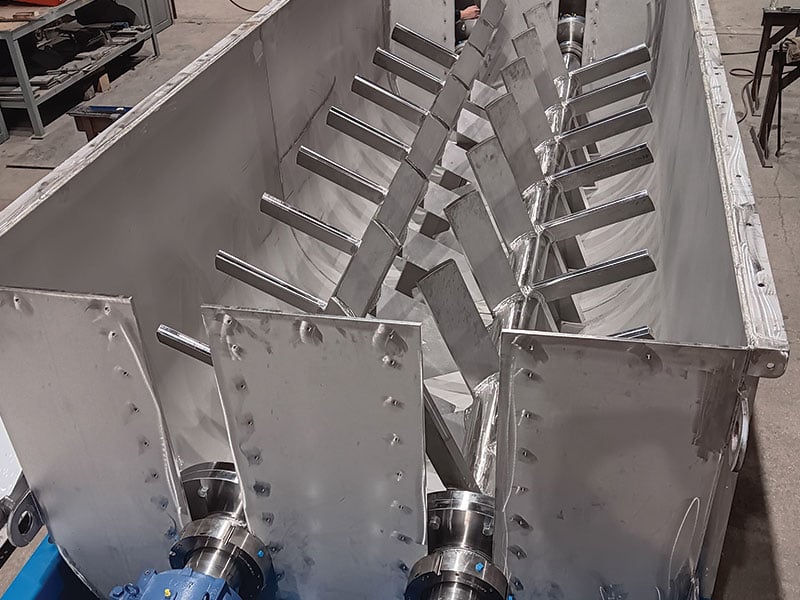
Interior view of a pugmill mixer
Drying, Screening, and Cooling
Once granules have been formed, they move on to drying, screening, and often cooling. Drying may be carried out in either a rotary dryer or fluid bed dryer.
A hammer mill breaks down screened over-size material, which is then combined with the under-size to be fed back into the process as recycle.
This process, without the addition of the granulation drum, is illustrated in the diagram below.
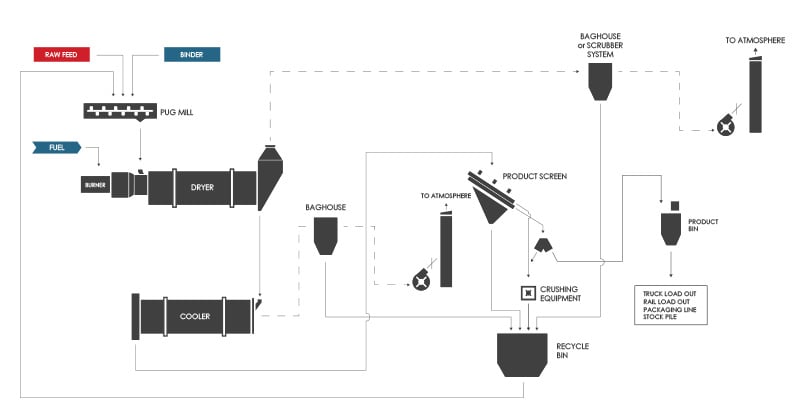
Mixer-dryer granulation process flow diagram for manure digestate
The resulting product is a dry, granular fertilizer that can be sold at a premium.
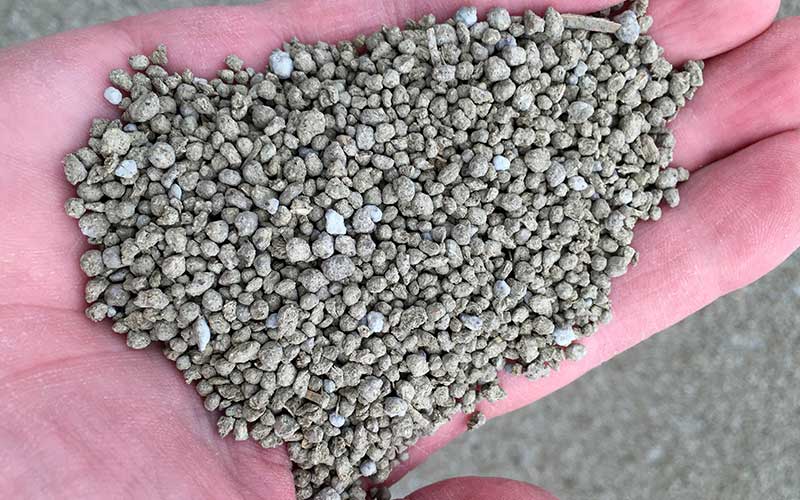
Manure-based fertilizer produced from on-farm digestate
Digestate Drying (Coarse Fiber Reuse)
It’s worth noting that the use of an anaerobic digester on dairy farms offers another important advantage. Whether they choose to granulate their digestate or not, farmers can opt to separate the coarse fibers from the digestate and reuse it as bedding for their cows. These coarse fibers are known as Recycled Manure Solids, or RMS, and have proven to offer a self-sustaining source of bedding.
This practice has become increasingly popular as traditional sources of bedding become more costly and difficult to acquire. RMS can also be dried to further reduce any bacteria and create a pasteurized Dried Manure Solids (DMS) bedding product.
This process is illustrated in the following diagram.
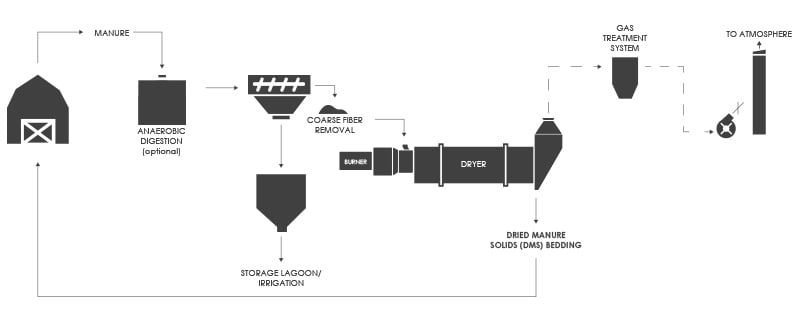
The diagram above illustrates the bedding recovery and drying process to convert manure into a Dried Manure Solids (DMS) bedding.
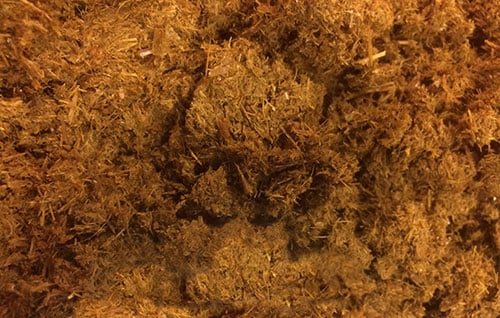
Dried Manure Solids (DMS) Bedding
When paired with granulation, the reuse of coarse fibers as bedding creates a circular approach that is highly effective in sustainably managing farm resources, diversifying revenue, and making the operation more self-sufficient. This combined approach is illustrated in the diagram below.
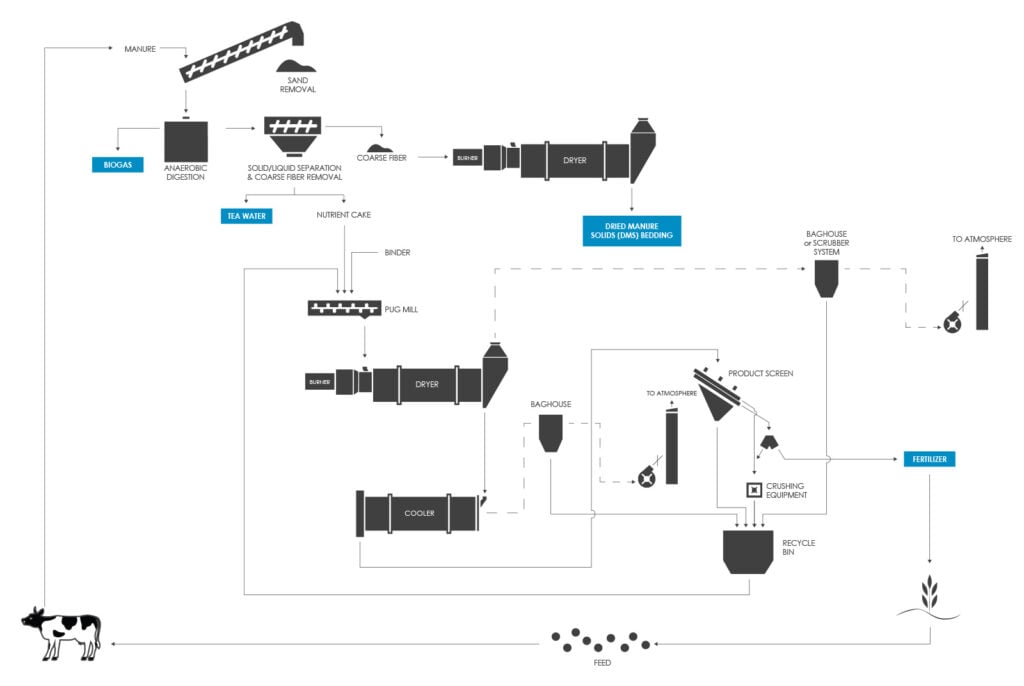
The diagram above illustrates a dairy farm utilizing both granulation and bedding recovery.
Conclusion
Implementing a digester creates a valuable opportunity for farms to create an additional stream of revenue, not only through biogas capture, but also through granulating the resulting solids. By granulating the concentrated nutrient cake remaining after digestion and solid/liquid separation, farms can create a saleable product. On dairy farms, the addition of a bedding dryer can also help the farm to become self-sufficient in meeting their bedding requirements.
FEECO is the industry leader in converting digestate into a premium fertilizer product, as well as high-quality bedding for use on dairy farms. We can offer process development testing, plant engineering, design and manufacturing of granulation equipment and bedding dryers, and even parts and service support. For more information on converting manure digestate into a fertilizer product, bedding, or both, contact us today!

